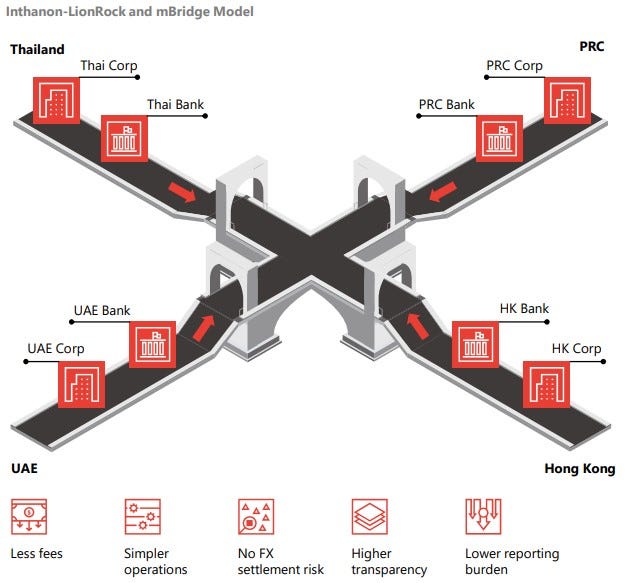UNLOCKED: Watch Pozsar's May 22nd Interview
Little coverage was given this conversation. We feel that was a mistake as Pozsar again gave us the answer key to the next 12 months, if only folks would listen
UPDATE: With the recent escalation in talk of dedollarization and the differing opinions swirling around what is a Global reserve currency, we decided to unlock this post.
Pozsar, in a very candid interview with an unaware Bitcoin-focused audience, details not only how dedollarization occurs, but announces that we are in the Anteroom of YCC, and therefore Financial repression. Section 6 is the dedollarization section, right before the bitcoin comments.
Strong recommendation to watch and read this if you are inclined
TL;DR
QE will restart relatively soon
No rate-cut in 2023
Oil at $150 will restart hikes
Dedollarization is accelerating
Bitcoin will not be State money
BONUS: “All you wanted to know about ChatGPT but were afraid to ask”
Interview Topics
Banking Crisis
QE Restarting
Inflation, Volcker, and Powell
Food/Energy Will Make Fed Keep Hiking
BRICS vs G7 on CBDC Use
Dedollarization Plumbing Explained
Bitcoin
1- Banking Crisis
I told my friend (who had gotten a great mortgage from FRC, “The next time you get a mortgage that’s too good to be true, short the bank stock that gave it to you”
Summary:
It was small-bank specific and a function of inexperienced risk mgt (SVB, FRC) and lopsided tech depositor base (SVB)
The BTFP was an impressive reaction to contain the crisis, and it is a kind of “foaming the runway for any of the large banks having problems down the road”
Forward Guidance:
One thing not yet tapped is the RRP, which functions as money in the mattress not needed by any financial institution yet. Implicitly if that is tapped and if the bigger banks like JPM choose to draw that down instead of collecting 5% interest as they currently are, then you know the problem is spreading. This sounds like next funding problem, if one happens, the Fed will tell them to tap it
2- QE Restarting
Hayes: Do you think the behavior of Gold and BTC are ‘seeing through’ these BTFP funding programs as highly inflationary?
Pozsar: Yes… (head nodding)
Summary:
These Fed vehicles just created to rescue banks’ nonperforming assets have the same effect as QE/YCC despite their technical differences.
These facilities tamp down longer term rates much in the same way as YCC does though not as obviously. We are in the “anteroom” for the next QE
By keeping bad loans from hitting the free market’s Yield Curve they force money seeking proper yield to go elsewhere. This is inflationary.
GoldFix from April 1st, The Bank Bailout is YCC
By lending to banks at face value for bonds/securities underwater by 30 to 60%, you remove the necessity for the banks to liquidate said securities in an open market to raise cash. Doing so removes upward pressure on interest rates that would by necessity occur from a fire-sale of these securities. You keep rates down.
Forward Guidance:
Financial Repression is when you use tools to skew issuance of treasuries towards the front end of the curve while keeping longer term yields low artificially. This migrates to the dollar itself and buying power gets killed. “There are many tell-tale signs here, you know…” of financial repression and YCC getting ready to happen. Meanwhile, as long as short term rates keep climbing, problems will continue to bubble up.
3- Inflation, Volcker, and Powell
Herodotus said “Circumstances rule men. Men do not rule circumstances”.-describing the difference between Volcker and Powell
Summary:
Volcker’s circumstances were significantly different than Powell’s are. Volcker raised rates sure, but commodity supply was already coming back on line in reaction to the 1970s oil crisis, the labor force was growing from women joining, Unions were weakened by Reagan, inflation indexing was on the way out.
Today, under Powell the exact opposite of everything under Volcker is occurring: Commodity shortages, Labor shortages, Equity redistribution is just getting started from Capital to Labor.
Forward Guidance:
The Fed is looking closely at real interest rate relationships in a spot-versus-forward sense. Right now real rates are positive in a forward sense, but not spot. They are waiting for that tipping point to hit up. Until positive real rates take hold in a spot sense, there will be no easing if they can help it. “Definitely no cuts [in 2023], a pause is not a cut”. They are waiting to see how BTFP gets used to handle next problems cropping up.
4- Food/Energy Will Make Fed Keep Hiking
“Can oil go from here to $150.. Likely. If it does what does that mean to the Fed— Nothing good because they have to respond.”
Summary:
A lot of non-linear events created this inflation. The Pandemic, the response both fiscally and monetarily, the war and geopolitics. But the things that will likely force the Fed hands now are a re-spike in goods inflation. Specifically food and energy are not in Fed control, and if they start accelerating with Services inflation still too high, The Fed will have to unpause.
Forward Guidance:
The Fed has almost no control over goods inflation since US goods are mostly imported. Rate hikes may slow demand, but they don’t necessarily drop prices if the goods are in short supply and others want them1. Service inflation however they were supposed to get lower much quicker. In this way, the Fed knows they’re very vulnerable to goods inflation resurging, especially if its due to another non-linear “shock” type event
5- BRICS vs G7 on CBDC Use
Over the past 12 months the RMB has gone from 1% trade financing to 5%… in 12 months! The Euro is about 8% over 15-20 years of existence…
Summary:
The BRICS and the G7 view digital currencies differently in their use case. BRICS gov’ts view them as a tool to do local bilateral commodity trade and get off the dollar for those. CBDC are on the surface a means to transact trade internationally in a mercantilist type environment.
The G7 cannot claim that use case ( in truth or even as a marketing ploy) to get them adopted. Therefore the West can only cite CBDC usefulness in ways that makes them a threat to freedom rather than an opportunity to get off the Dollar.
Forward Guidance:
Expect the West to create its own CBDC for int’l trade when/if the BRICS are successful and after the Ukraine war winds down.
6- Dedollarization Plumbing Explained
It’s all going to be at the expense of the dollar share of assets.
Summary:
Less dollars will be used in commodity trade. Therefore less dollars need to be held. Given the world has no other good asset to substitute for US Treasuries, Treasuries will still be what is held by the other CBs. The main difference is, when they get paid dividends, they will immediately swap the dollars for currencies they actually use for trade. This means dollars are left orphaned floating out there lowering their value not being held closely by the banks anymore
Forward Guidance:
They are thinking that beyond YCC the Fed can change rules governing deposit creation for Banks handling Treasuries and give the orphaned dollars a counterbalancing need to be held. This is all to mitigate a more aggressive debasement of USD buying power if needed. The US will have to buy its own bonds one way or another.
Note: Pozsar goes into Perry Mehrling’s 4 prices of money concept here.2 More on that at bottom and in The Four Prices of Money
7- Bitcoin
Hayes: Do you think the Fed will ever put any of its balance sheet in Bitcoin?
Pozsar: I don’t think so. No.
Summary:
Throughout history all money has either been Public (State created) or a Public/Private partnership. Bitcoin, while it has been adopted by a couple nations, is not controlled by those nations. FX reserve managers may put a % of their reserves in BTC like Gold at some point . While both gold and Bitcoin are trustless. Bitcoin is man made and the product of private enterprise.
Forward Guidance:
The entirety of Bitcoin’s construct is private. If there is a problem with the money itself, the State has no control over it and thus they have no recourse to mitigate the problem. Outsourcing something core to your country’s existence is dangerous. Anything with moving parts not created by and operated by the State is a risk to the State. Which is why they are creating their own CBDC. To borrow a phrase: The government is saying, not our keys, not our coins. Of course this is also an excuse to increase societal control and they will do that. Why? Because Bitcoin’s existence alone threatens state existence.
End
Premium Bonus: CHATGPT overview…
Also as one Founder noted. Companies have no qualms passing higher costs on to customers in goods with largely inelastic demand. This is the ”price gouging” effect many accuse them of now though that is very debatable. Prices go up, but demand doesn’t drop…
We disagree with his framing of the 4 prices as being implicitly on equal footing. Each of the 4 definitions of money is not to us equally ranked, but hierarchically different because of varying degrees of derivative and financial leverage. We wrote extensively on this here. The only thing to add is: The fact that Pozsar describes the Fed as needing to secure the Treasury “price of money” of the 4 definitions combined with his framing of this as moving the Fed’s “put” from the stock market to the bond market implies the Fed also sees this as hierarchically a retreat from the most esoteric price of money much closer to the unleveraged root/base of it. Exter’s pyramid style, in other words.










Great summary of an informative interview. Thank you.